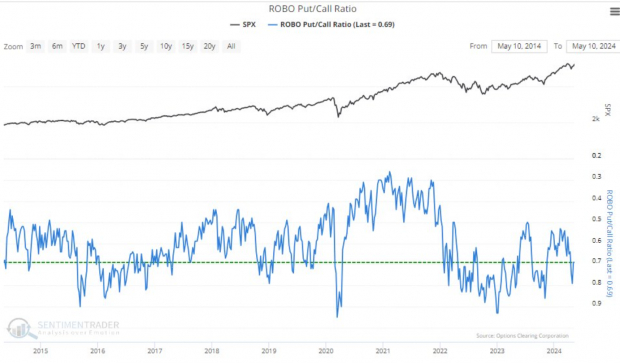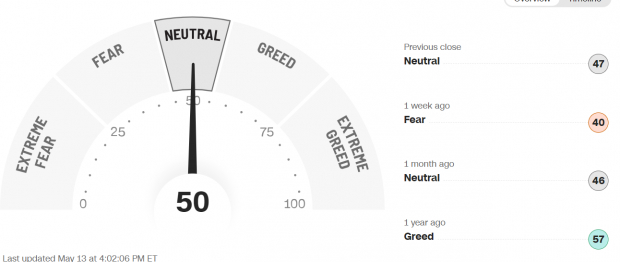
With turmoil in the Kremlin and no movement towards a ceasefire in the Middle East the market maintained a steady course on Monday, ahead of data dumps later in the week. depositphotos On Monday the S&P 500 closed at 5,221, down 1.26 points, the Dow closed at 39,432, down 81points and the Nasdaq Composite closed up 47 points at 16,388.
depositphotos On Monday the S&P 500 closed at 5,221, down 1.26 points, the Dow closed at 39,432, down 81points and the Nasdaq Composite closed up 47 points at 16,388.  Chart: The New York Times Most actives were led by Uber (UBER), down 5.7%, followed by Tesla (TSLA), down 1.7% and Intel (INTC), down 2.2%.
Chart: The New York Times Most actives were led by Uber (UBER), down 5.7%, followed by Tesla (TSLA), down 1.7% and Intel (INTC), down 2.2%.  Chart: The New York Times In early morning futures trading S&P 500 market futures are up 1 point, Dow market futures are up 10 points and Nasdaq 100 market futures are up 2 points.TalkMarkets contributors Lance Roberts and Michael Lebowitz in a TalkMarkets Editor’s Choice column write that The Correction Is Over As Stocks Bounce Back. “This past week, the market broke above the 50-DMA with a solid confirmation of the MACD “buy signal.” Currently, the market is decently overbought after the advance, so a pullback to retest the 50-DMA would be welcome. Such a pullback would turn the 50-DMA from previous resistance into support and reduce some overbought conditions.
Chart: The New York Times In early morning futures trading S&P 500 market futures are up 1 point, Dow market futures are up 10 points and Nasdaq 100 market futures are up 2 points.TalkMarkets contributors Lance Roberts and Michael Lebowitz in a TalkMarkets Editor’s Choice column write that The Correction Is Over As Stocks Bounce Back. “This past week, the market broke above the 50-DMA with a solid confirmation of the MACD “buy signal.” Currently, the market is decently overbought after the advance, so a pullback to retest the 50-DMA would be welcome. Such a pullback would turn the 50-DMA from previous resistance into support and reduce some overbought conditions. 


 Image Source: SentimentraderFear & GreedThe CNN Fear and Greed Index paints a similar picture to the put/call ratio. Though the major indices are a hair-off all-time highs, the CNN Fear and Greed Index is showing a “Neutral” sentiment.
Image Source: SentimentraderFear & GreedThe CNN Fear and Greed Index paints a similar picture to the put/call ratio. Though the major indices are a hair-off all-time highs, the CNN Fear and Greed Index is showing a “Neutral” sentiment. Image Source: CNN” Contributor Adam Hamilton looks at Big U.S. Stocks’ Q1’24 Fundamentals.”The big US stocks dominating markets and investors’ portfolios continue to thrive. They are finishing up another earnings season covering a record-breaking quarter, reporting some fantastic results. Still, these fat underlying profits are growing far slower than major companies’ soaring stock prices. That has forced valuations deeper into dangerous bubble territory, fueling mounting risks for awakening a new bear market…As always big US stocks’ latest Q1’24 results are important for gaming stock markets’ likely direction in coming months. For 27 quarters in a row now, I’ve analyzed how the 25 largest US companies that dominate the SPX fared in their latest earnings seasons. Exiting Q1, these behemoths commanded a stunning record 46.8% of the SPX’s total market cap! Their latest reported key results are detailed in this table…
Image Source: CNN” Contributor Adam Hamilton looks at Big U.S. Stocks’ Q1’24 Fundamentals.”The big US stocks dominating markets and investors’ portfolios continue to thrive. They are finishing up another earnings season covering a record-breaking quarter, reporting some fantastic results. Still, these fat underlying profits are growing far slower than major companies’ soaring stock prices. That has forced valuations deeper into dangerous bubble territory, fueling mounting risks for awakening a new bear market…As always big US stocks’ latest Q1’24 results are important for gaming stock markets’ likely direction in coming months. For 27 quarters in a row now, I’ve analyzed how the 25 largest US companies that dominate the SPX fared in their latest earnings seasons. Exiting Q1, these behemoths commanded a stunning record 46.8% of the SPX’s total market cap! Their latest reported key results are detailed in this table… The US stock markets have grown increasingly top-heavy, which is a serious risk. Exiting Q1, the SPX’s 25 largest component stocks again represented 46.8% of its entire weighting! Dramatically soaring since the 34.8% in Q3’17 when I launched this deep quarterly research thread, that extreme concentration is troubling. The fewer stocks any bull market depends on to drive it, the more fragile and precarious it is.These US stock markets are heavily reliant on the beloved Magnificent 7 mega-cap technology stocks. Together mighty Microsoft, Apple, NVIDIA, Alphabet, Amazon, Meta Platforms, and Tesla now account for a staggering 29.1% of the SPX’s total market cap! The Mag7’s gargantuan total $13,587b exceeded the total of the SPX’s bottom 403 components. These market darlings essentially are the US stock markets.Their outperformance remains dramatic, with the Mag7’s market cap skyrocketing 50.6% over the year ending Q1’24! That almost doubled the entire S&P 500’s 27.9% gain, which means the vast majority of its other 493 stocks seriously underperformed. While these mega-cap-tech giants are fantastic American companies with amazing fundamentals, their stocks are still exceedingly overvalued as we will soon discuss.So another dynamic is fueling their outsized gains, and disturbingly it is peer pressure. Since the lion’s share of US-stock-market gains have come from the Mag7, professional fund managers have no choice but to way overweight their allocations. Without heavy Mag7 exposure, their funds’ performances will lag well behind their peers’. Underperforming too long in the money-management business is the kiss of death…The bottom line is big US stocks just reported another great quarter. Led by the beloved mega-cap techs, revenues and earnings utterly soared. But despite that, valuations still remain deep in dangerous bubble territory. The US stock markets are wildly overpriced compared to underlying corporate earnings, which portends a serious bear looming. It will maul markets, forcing stock prices lower until profits catch up…”So, some “bad news” to digest. The author is a gold believer.Contributors from the Staff of ING Economics note on their FX Daily: Slow Disinflation, Low Volatility.”Today’s PPI and tomorrow’s CPI figures will tell us whether the US has made further steps in the disinflation process, or if prices remain too sticky for the Federal Reserve to cut. The latter seems more likely, and a consensus call too – which could leave FX markets without much sense of direction and volatility still depressed…
The US stock markets have grown increasingly top-heavy, which is a serious risk. Exiting Q1, the SPX’s 25 largest component stocks again represented 46.8% of its entire weighting! Dramatically soaring since the 34.8% in Q3’17 when I launched this deep quarterly research thread, that extreme concentration is troubling. The fewer stocks any bull market depends on to drive it, the more fragile and precarious it is.These US stock markets are heavily reliant on the beloved Magnificent 7 mega-cap technology stocks. Together mighty Microsoft, Apple, NVIDIA, Alphabet, Amazon, Meta Platforms, and Tesla now account for a staggering 29.1% of the SPX’s total market cap! The Mag7’s gargantuan total $13,587b exceeded the total of the SPX’s bottom 403 components. These market darlings essentially are the US stock markets.Their outperformance remains dramatic, with the Mag7’s market cap skyrocketing 50.6% over the year ending Q1’24! That almost doubled the entire S&P 500’s 27.9% gain, which means the vast majority of its other 493 stocks seriously underperformed. While these mega-cap-tech giants are fantastic American companies with amazing fundamentals, their stocks are still exceedingly overvalued as we will soon discuss.So another dynamic is fueling their outsized gains, and disturbingly it is peer pressure. Since the lion’s share of US-stock-market gains have come from the Mag7, professional fund managers have no choice but to way overweight their allocations. Without heavy Mag7 exposure, their funds’ performances will lag well behind their peers’. Underperforming too long in the money-management business is the kiss of death…The bottom line is big US stocks just reported another great quarter. Led by the beloved mega-cap techs, revenues and earnings utterly soared. But despite that, valuations still remain deep in dangerous bubble territory. The US stock markets are wildly overpriced compared to underlying corporate earnings, which portends a serious bear looming. It will maul markets, forcing stock prices lower until profits catch up…”So, some “bad news” to digest. The author is a gold believer.Contributors from the Staff of ING Economics note on their FX Daily: Slow Disinflation, Low Volatility.”Today’s PPI and tomorrow’s CPI figures will tell us whether the US has made further steps in the disinflation process, or if prices remain too sticky for the Federal Reserve to cut. The latter seems more likely, and a consensus call too – which could leave FX markets without much sense of direction and volatility still depressed… 
 Pixabay “Let’s give credit where credit is due.Facing a record-high budget deficit and an entrenched inflation problem, the government is finally embracing fiscal responsibility in a significant way.Thanks to sweeping spending cuts enacted this year, the government has posted three consecutive monthly budget surpluses – leading to a reduction in money supply growth and a marked lessening of inflation pressures.This hopeful state of affairs doesn’t apply to the government of the United States, of course. It describes what the government of Argentina is achieving under its new president, Javier Milei.The free-market economist turned politician had campaigned with a chainsaw in hand, vowing to cut government bureaucracy and bring down Argentina’s triple-digit inflation rate.The media dismissed him as an eccentric protest candidate. Then when he shocked everyone by winning the election decisively, the media said he couldn’t or wouldn’t actually follow through on his bold campaign promises.Rare is the politician who does.But after just a few months in office, Milei has actually abolished dozens of agencies and fired thousands of state bureaucrats. He has slashed government bureaucracy by as much as 50%.Milei has declared there will simply be no more deficit spending in Argentina: “Zero deficit isn’t just a marketing slogan for this government, it is a commandment.”Conquering inflation remains a work in progress. After decades of rule by socialist politicians who promised endless streams of benefits that were never fully paid for, Argentina’s economy was careening toward ruinous hyperinflation.Last month, the monthly inflation rate in Argentina fell below 10% for the first time in years.The official inflation rate in the United States has never reached Argentinean proportions. But its spiraling debt is starting to draw comparisons to countries that have seen their currencies and economies collapse due to reckless fiscal and monetary policy.Washington, D.C. has been warned over and over again that it needs to change its spending habits. U.S. government debt has been downgraded twice by major credit ratings agencies. Its own central bank has called its fiscal path “unsustainable”…the International Monetary Fund is warning that unsustainable growth in U.S. government debt – which is projected to soar from $34 trillion to $46 trillion within a decade – poses a threat to the global financial system.Meanwhile, Congress has just refused to even consider the recommendations of a bipartisan commission on tackling the debt.Legislators have decided that they don’t want to be told they are spending too much money they don’t have and are promising too many people too many benefits that cannot be paid.It seems clear at this point that politicians will not act to avert a crisis. They will only act in response to one when they have no other alternative.For a brief period in the late 1990s, it appeared as though federal finances were on a sustainable path. Republicans in Congress pushed hard to balance the budget. And President Bill Clinton famously declared, “The era of big government is over.”The era of big government wasn’t over, of course. It continued to grow year after year regardless of which party controlled the levers of power in any given year. And despite former President Donald Trump’s vows to “drain the swamp,” the D.C. swamp is now bigger and murkier than ever.Nobody in Washington even talks seriously about balancing the budget anymore…Will the United States become the next Argentina? It’s looking like the U.S. will have to experience a much worse inflation problem before the government feels compelled to change course. Things will likely have to get worse before they get better.”That’s a wrap for this Tuesday morning.Have a good one.Peace.
Pixabay “Let’s give credit where credit is due.Facing a record-high budget deficit and an entrenched inflation problem, the government is finally embracing fiscal responsibility in a significant way.Thanks to sweeping spending cuts enacted this year, the government has posted three consecutive monthly budget surpluses – leading to a reduction in money supply growth and a marked lessening of inflation pressures.This hopeful state of affairs doesn’t apply to the government of the United States, of course. It describes what the government of Argentina is achieving under its new president, Javier Milei.The free-market economist turned politician had campaigned with a chainsaw in hand, vowing to cut government bureaucracy and bring down Argentina’s triple-digit inflation rate.The media dismissed him as an eccentric protest candidate. Then when he shocked everyone by winning the election decisively, the media said he couldn’t or wouldn’t actually follow through on his bold campaign promises.Rare is the politician who does.But after just a few months in office, Milei has actually abolished dozens of agencies and fired thousands of state bureaucrats. He has slashed government bureaucracy by as much as 50%.Milei has declared there will simply be no more deficit spending in Argentina: “Zero deficit isn’t just a marketing slogan for this government, it is a commandment.”Conquering inflation remains a work in progress. After decades of rule by socialist politicians who promised endless streams of benefits that were never fully paid for, Argentina’s economy was careening toward ruinous hyperinflation.Last month, the monthly inflation rate in Argentina fell below 10% for the first time in years.The official inflation rate in the United States has never reached Argentinean proportions. But its spiraling debt is starting to draw comparisons to countries that have seen their currencies and economies collapse due to reckless fiscal and monetary policy.Washington, D.C. has been warned over and over again that it needs to change its spending habits. U.S. government debt has been downgraded twice by major credit ratings agencies. Its own central bank has called its fiscal path “unsustainable”…the International Monetary Fund is warning that unsustainable growth in U.S. government debt – which is projected to soar from $34 trillion to $46 trillion within a decade – poses a threat to the global financial system.Meanwhile, Congress has just refused to even consider the recommendations of a bipartisan commission on tackling the debt.Legislators have decided that they don’t want to be told they are spending too much money they don’t have and are promising too many people too many benefits that cannot be paid.It seems clear at this point that politicians will not act to avert a crisis. They will only act in response to one when they have no other alternative.For a brief period in the late 1990s, it appeared as though federal finances were on a sustainable path. Republicans in Congress pushed hard to balance the budget. And President Bill Clinton famously declared, “The era of big government is over.”The era of big government wasn’t over, of course. It continued to grow year after year regardless of which party controlled the levers of power in any given year. And despite former President Donald Trump’s vows to “drain the swamp,” the D.C. swamp is now bigger and murkier than ever.Nobody in Washington even talks seriously about balancing the budget anymore…Will the United States become the next Argentina? It’s looking like the U.S. will have to experience a much worse inflation problem before the government feels compelled to change course. Things will likely have to get worse before they get better.”That’s a wrap for this Tuesday morning.Have a good one.Peace.  Pexels More By This Author:Thoughts For Thursday: New Highs Expected While Market Slows
Pexels More By This Author:Thoughts For Thursday: New Highs Expected While Market Slows
Tuesday Talk: Still Flying
Thoughts For Thursday: Lingering Inflation















